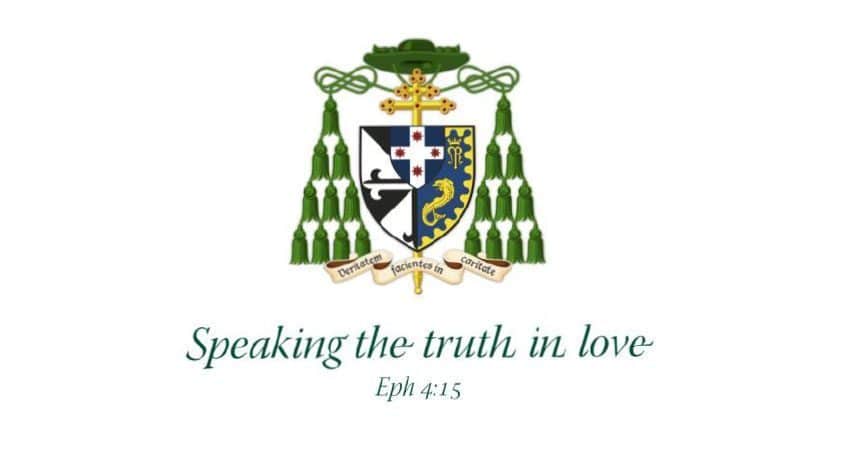HOMILY FOR MASS OF THE 4TH SUNDAY OF EASTER YEAR A SHRINE OF ST MARY OF THE CROSS MACKILLOP, NORTH SYDNEY

HOMILY FOR MASS OF THE 4TH SUNDAY OF EASTER YEAR A
SHRINE OF ST MARY OF THE CROSS MACKILLOP, NORTH SYDNEY
When on visitation some years ago in this very parish of North Sydney, I went to the parish primary school. As I entered a tiny-tot, who saw I was unusually dressed, asked what I was. “I’m a bishop,” I explained, to which he responded, quick-as-a-flash, “Are you a chess piece then?”
Sometimes when visiting schools, especially before Confirmation, I bring my mitre and crozier for show and tell, and to help answer questions such as whether I am a chess piece. When I ask the children what the stick is, I am reminded how very old I seem to them, as some have suggested it’s my walking stick. Usually, however, a smart kid identifies it as a shepherd’s staff. When one now-retired auxiliary bishop of Sydney asked why he carried one of these, a wide-eyed child responded, “Because you’re Little Bow Peep!”
Despite the confusion, bishops persevere in using a pastoral staff – with its crook, for catching straying sheep and lifting out those caught between a rock and a hard place; with its pointed finial, for goading reluctant ones in the right direction; and with the rod in between, that serves as a solid support in fights with bandits and wolves. The crozier signifies that the bishop’s office is to point people in the right direction, goad the spiritually lazy, draw back the strays, defend all from spiritual attack and be their strong support.
Of course, some other symbol might have served to symbolise the mission of bishops. We could, for instance, have carried fishing rods: for fishing is another New Testament metaphor for the apostolate. Or we might have carried a whip: after all, the Greek word ἐðßóêïðïò, from which we get our words bishop and episcopal, refers to an overseer who keeps the labourers working. Bishops could carry big keys, since they share in the Petrine task of unlocking the mysteries by teaching and judging. Some other symbol might better capture the life of the modern bishop: perhaps a monster book of meeting minutes or a king-sized iPhone with both the Divine Office and the Chancery Office on it. Some would outfit bishops with the accoutrements of constitutional monarchs, reserving the sceptre of governance to a parliament of lay experts or to the fourth estate. Others would adorn us with the laser pointer of a company director. But no: bishops carry a shepherd’s crook to evoke the Gospel image of the Good Shepherd (Jn ch. 10).
arisons with sheep and shepherds don’t have quite same resonance they had in the Ancient Near East. Our flocks of sheep are commonly numbered in their thousands and could not possibly be known by name; they are there to be fleeced or butchered. Nor does the word ‘sheep’ conjure up for us a thoughtful or courageous person: sheep are seen as unimaginative, irresolute, expendable. If someone described this congregation as ‘a bunch of sheep’ or said the choir ‘bleated like sheep’ or said the bishops had ‘sheepish grins’, it wouldn’t be a compliment!
Why is it, then, that when Jesus compares us with sheep who listen to His voice, we’re not insulted at all? Because we know He never exploits us. In our hunger this Good Shepherd nourishes us; in our vulnerability, protects us; in our confusion, guides us; in our every need, cares for us – with a love and wisdom and power no earthly farmer does.
Jesus as our Shepherd is one thing, but none of us wants a sheep-to-shepherd relationship with any earthly power: no-one says “Mr Turnbull is my shepherd” or Mr Shorten, even on a good day. And whether because of the spectacular scandals or more mundane mediocrity, people today are often ambivalent about their clergy as shepherds or themselves as flock. Here we touch on the mystery of the vocation for which we pray on Good Shepherd Sunday: that God uses ordinary human beings, with all their foibles, as pastoral ministers, as His bishops and priests.
The performance of some bishops, priests and religious has lately been the subject of considerable criticism, and this has left many disenchanted. Yet even the first apostles were often boneheaded and pusillanimous, of rather ordinary education and imagination, ever-ready under fire to flee the scene. They wouldn’t gain entry to a modern seminary! Yet it was these weaklings whom Jesus called and formed to be strong shepherds. It was to these unreliable souls that He entrusted the protection and feeding of His flock. It was upon these low-spirited men that the Easter Lord breathed His Holy Spirit to enable them to govern and teach, absolve and confirm, lead and serve according to His mind. The only reason Catholics take their clergy so seriously is that they trust that Christ can make more of those men than their own gifts and shortcomings would suggest, turning them to His own purposes. Bishops and priests are taken from among ordinary men, a fact I appreciate more clearly every time I reflect on my own weaknesses. Which is why we pray for them in every Mass, even as they pray for us all.
None of which excuses magnifying or ignoring the limitations of our spiritual leaders. We now know we need better psychological testing and discernment of vocations, more comprehensive human, spiritual, intellectual and pastoral formation before beginning ministry and after, better supervision, appraisal and support, for our clergy, religious and Church workers. We’ve already made some advances here and are determined to see more. But however professional our processes going forward, we must remember that the goal is shepherds after the mind and heart of the Good Shepherd.
What should we be looking for in our pastors? Our Gospel suggests good shepherds give themselves totally for their flock; they know their flock intimately; they nurture, unite, protect and lead them. Shepherds are also simple, straight, clear thinkers; they don’t operate in innuendo or ambiguity; and they are doers rather than bureaucrats. They work both in teams and alone. They receive and pass on their craft. And they do most of what they do sight-unseen and uncelebrated.
To say ours is an apostolic Church, means it is one led by bishops in succession from the apostles, teaching what they taught and leading as they led. The Second Vatican Council even dared say, following the ancient Fathers, that to listen to the bishops is to listen to Christ. Only those with great faith could believe such a claim! But if we believe that Christ is God’s definitive revelation to all humanity, not just those in ancient Palestine but even to those in North Sydney in 2017, then we must believe He established some mechanism by which His words would be safely conveyed, His will honestly interpreted, His grace generously shared, and His works mercifully done, in all future generations. In His strange wisdom the means He chose were bishops – the shepherds of the Church.
Simply by virtue of their Baptism, the faithful share in Christ’s priestly mission. Bishops also share their pastoral office in various ways with priests and deacons, religious and lay pastoral workers. As a result, in the absence of bishops, the Church often carries on regardless; indeed, it seems to do very nicely thank-you. But talk to the people of Townsville, with a new bishop this week after waiting three years, and they’ll testify to how crucial shepherds are for a Church such as ours. Today we pray for more and better pastors for Australia. And I ask you, of your mercy, to pray for these particular men concelebrating with me today, the chief Shepherds of Christ’s flock in Australia.
INTRODUCTION FOR MASS OF THE 4TH SUNDAY OF EASTER YEAR A
SHRINE OF ST MARY OF THE CROSS MACKILLOP, NORTH SYDNEY
Welcome to our Mass for the Fourth Sunday of Easter, Good Shepherd Sunday, the 54th World Day of Prayer for (Priestly) Vocations. It is an especially fitting day to welcome the Bishops of Australia to Sydney for the Plenary Meeting of the Australian Catholic Bishops Conference: on behalf of the Archdiocese a very warm welcome to our chief shepherds!
We bishops are privileged to meet by the tomb of St Mary of the Cross MacKillop, who despite occasional, even spectacular, difficulties with bishops and priests, was a great supporter of those vocations, as of other vocations. We thank the Sisters of St Joseph and the regular worshippers here for sharing their shrine and Sunday Mass with us. To everyone present a very warm welcome!

